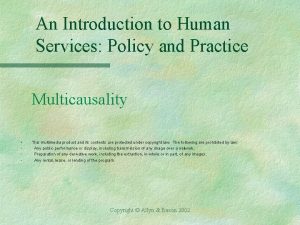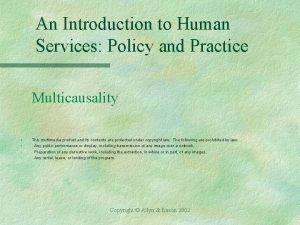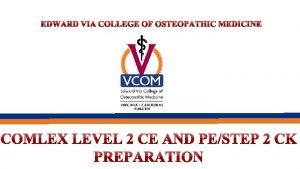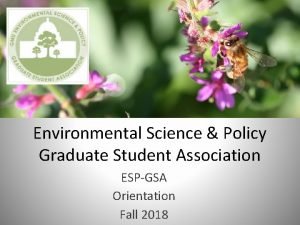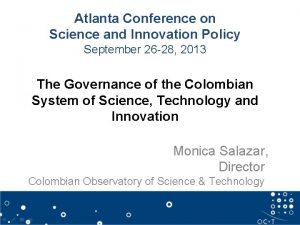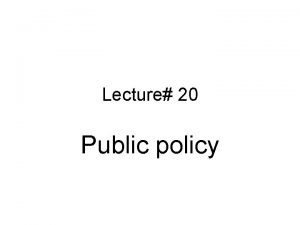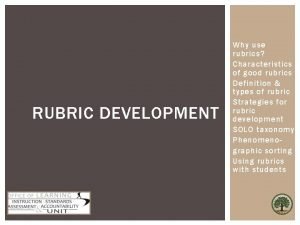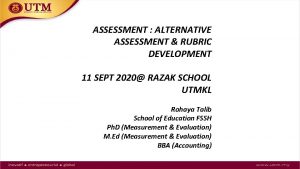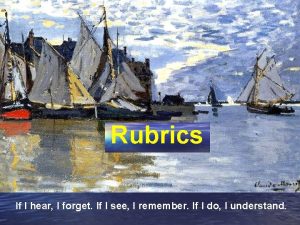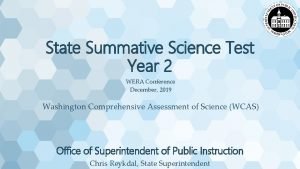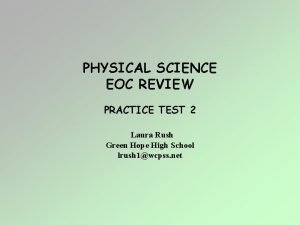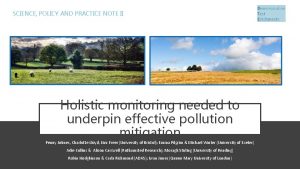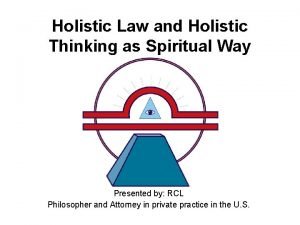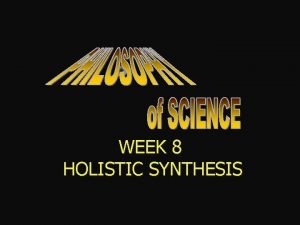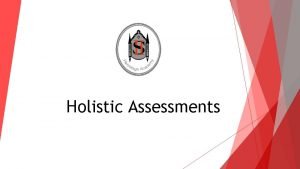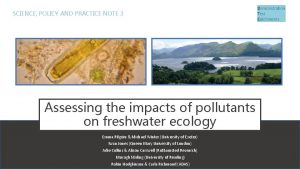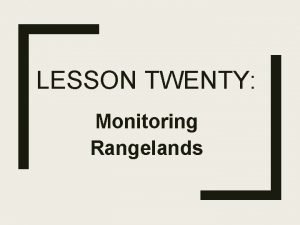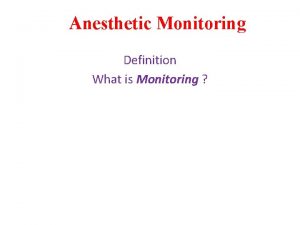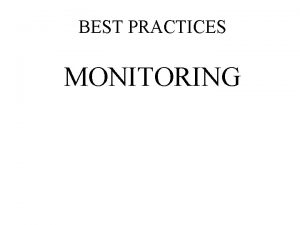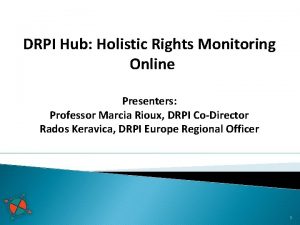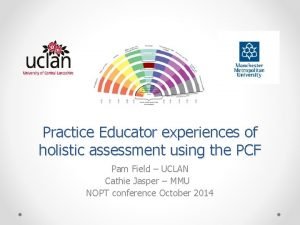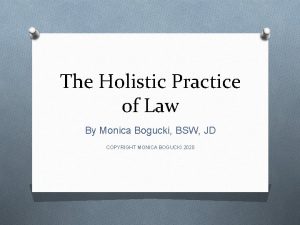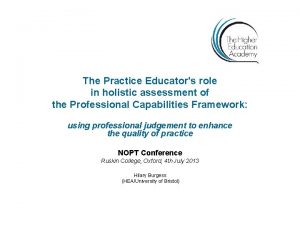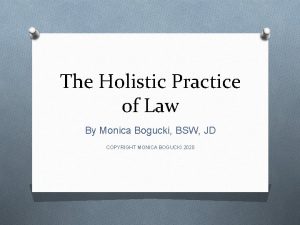SCIENCE POLICY AND PRACTICE NOTE II Holistic monitoring




























- Slides: 28

SCIENCE, POLICY AND PRACTICE NOTE II Holistic monitoring needed to underpin effective pollution mitigation Penny Johnes, Charlotte Lloyd, Kim Freer (University of Bristol); Emma Pilgrim & Michael Winter (University of Exeter) Adie Collins & Alison Carswell (Rothamsted Research); Moragh Stirling (University of Reading) Robin Hodgkinson & Carla Richmond (ADAS); Iwan Jones (Queen Mary University of London)

The issue Nutrient enrichment of inland coastal waters is a growing global problem with significant adverse effects on human health and the landscape and therefore substantial implications for the public purse and the living world. Existing UN and EU policies require effective monitoring to identify pollution sources for mitigation.

Nutrient cycling All living organisms need carbon, nitrogen and phosphorus to sustain life. These are referred to as essential or limiting nutrients. A nutrient cycle refers to the use, cycling, uptake and transfer of nutrients in the environment.

What is nutrient cycling?

Nitrogen (N) cycling N is needed to create amino acids, the building blocks of all animal and plant protein. The largest store of N is as N 2 gas in the atmosphere. Soil Bacteria convert this N 2 gas into N compounds that can be used by plants e. g. nitrate (NO 3 -), and ammonium (NH 4+). Soil bacteria and fungi decompose excreted organic compounds containing N such as urine, manures, slurries, as well as animals and leaf litter, recycling N.

Nitrogen (N) cycling The decomposition process also builds up N in soil organic matter. These forms of N can be readily flushed out of soil with water flowing through the soils to streams. Excess N added directly to the soil as either an inorganic fertiliser, or in the form of slurries and manures can be washed from the land into streams.

Phosphorus (P) cycling P is an essential element forming DNA and cell membranes in plants and animals. Only a limited amount of P occurs naturally in the soil, via decomposition of dead organic matter, or much more slowly by weathering of P minerals in rocks. Excess P is also added to soil as either an inorganic fertiliser or organic slurries and manures.

Phosphorus (P) cycling P may be flushed to streams from P-enriched soils as dissolved inorganic or dissolved organic P or delivered in the form of particulate P as soils erode. If these P-enriched soil particles are eroded from bare agricultural land e. g. freshly tilled fields or grasslands poached by livestock, they are transported to streams, where the particulate P can be released into waterbodies as inorganic phosphate. All P and N forms can be taken up by animal/plant life, generating adverse impacts on ecosystem health e. g. through eutrophication.

The impact of agriculture on nutrient cycling MODERN FARMING PRACTICES RELY ON FAST GROWING CROPS WHICH REQUIRE READILY AVAILABLE SOIL NUTRIENTS FOR GROWTH. DEMAND FOR MEAT IS OFTEN ACHIEVED THROUGH INTENSIVE LIVESTOCK FARMING. CONSEQUENTLY, ANIMAL MANURES AND URINE ARE DIRECTLY PASSED ONTO THE SOILS OR COLLECTED IN YARDS AND APPLIED AS A SLURRY OR MANURE TO AGRICULTURAL LAND. APPLYING FERTILISERS OR MANURES OR SLURRIES DURING PERIODS OF WET WEATHER OR VERY CLOSE TO WATERCOURSES FURTHER INCREASES THE RISK OF NUTRIENT EXPORT TO WATERS.

The impact of agriculture on nutrient cycling Many farmers may not consider the nutrient content of these organic additions when calculating the inorganic fertiliser application rate for crops/grass and continue to apply high loadings of inorganic fertilisers. The quantity of nutrients then outstrips the crop’s demand, leading to the excess nutrients being flushed out of the soil during periods of rainfall These mobilised nutrients may leach downward into groundwater aquifers or move laterally into surface waters such as streams, rivers and lakes.

The rate at which nutrients flush from their sources to adjacent waterbodies depends on: Climate Geology How often there are sudden intense rainfall events which have the energy to move large quantities of nutrients and sediments from land to water. How permeable the rock is and whethere is an aquifer which might reduce the amount of water running quickly from land to stream during rainfall events. Topography How steeply sloping the land is, and how well-connected distant areas of land are to the stream network. Land use Whethere is crop cover all year round, nature & intensity of crop production, nature/timing of fertiliser applications, stocking density & manure/slurry management regime. Soils How wet soils are, their exposure to rainfall, their binding capacity and water storage capacity, and their susceptibility to erosion. As a result, there are varying sources, chemistries and characteristics of nutrient pollution in catchments with differing environmental character.

Sources of nutrient and sediment flux to waters in intensive ARABLE farming catchments

Sources of nutrient and sediment flux to waters in intensive LIVESTOCK farming catchments

Mitigating nutrient pollution While the geoclimatic character of a landscape cannot be controlled, we can strongly influence how we use and manage the land, and thus control the nature, rates and timing of pollutant flux within a catchment. We need a better understanding of the interaction between the environment, land use and management in creating the particular rates and chemical nature of the nutrient pollution in any catchment. Then we can identify the most effective methods of measuring and mitigating pollutant flux in that landscape.

The Demonstration Test Catchment Project (DTC) DTC is a multi-partner collaborative research programme comprising academics, farmers, industry experts, environmental organisations and policymakers which explores solutions to improving water quality in agricultural landscapes. The effects of different mitigation measures have been monitored from 2010/11 - 2019 in four river systems: 1. Eden (Cumbria) 2. Avon (Hampshire, Wiltshire) 3. Wensum (Norfolk) 4. Tamar (Devon/Cornwall) As these catchments represent major UK soil/rainfall combinations found on typical English and Welsh farms, the data collected from this work can be applied to other locations

DTC focused on assessing nutrient fluxes in different types of intensive farming systems practiced in catchments with different environmental characters These combinations of farming type and environmental character were chosen to reflect conditions found across much of lowland Britain, making findings relevant to other unmonitored locations. Demonstration Test Catchments (DTC) programme

Recent research evidence data from DTC Samples were collected daily and sub-daily between 2011 -2014 and analysed to determine the full range of nutrient pollutants flushed to multiple sites within the Hampshire Avon and Tamar from sources in their catchments. Rainfall and river discharge were also measured, allowing calculation of the total load of each nutrient form in the river at each site. This allowed an assessment of the total nutrient load moving into and through each water system, and the likely origins of this material within the landscape at each site.

Lessons learnt: chalk catchments Catchment character determines the nature and timing of nutrient flux to waters and the nature and rate of the ecosystem response to pollution mitigation measures. Chalk catchments supporting intensive arable/mixed farming show slow responses to heavy rainfall, with most of rainfall travelling to streams via slower groundwater flow pathways.

Lessons learnt: chalk catchments Nitrate flux was dominated by leaching from soils to groundwater Phosphate delivery to waters was dominated by the erosion of P-rich soils from arable land. P-rich fine sediments stored in the gravel bed in chalk streams contributed to significant adverse ecosystem impacts on aquatic plant, insect and fish health.

Lessons learnt: clay catchments Clay catchments, typically supporting intensive livestock farming, have less water moving through as infiltration rates are slow in heavy soils. Instead, most water runs over the soil surface or through field drains, generating rapid delivery of manures, slurries and eroded organic and nutrientrich soil to adjacent waters.

Lessons learnt: clay catchments N and P delivery to streams is dominated by particulate and organic matter, contributing significantly to ecosystem degradation and stimulating microbial activity in the stream which saps the oxygen needed to support animal life. Similar impacts of nutrient enrichment on aquatic plant health to those observed in chalk streams also arise.

Lessons learnt N and P form a substantial portion of the total nutrient load generating adverse impacts on ecosystem health in chalk and clay systems. Large amounts of nutrient flux to waters would be missed in any lower-frequency (weekly, monthly) monitoring programme. A high proportion of nutrient loading is also delivered to waters in forms that are not typically determined in routine water quality monitoring programmes. Daily long-term monitoring of all nutrient fractions is therefore essential to capture a representative picture of total nutrient loads driving ecosystem degradation in rural catchments, and to generate the robust evidence needed to underpin effective targeting of pollution mitigation efforts.

The response of any catchment and its aquatic ecosystem to mitigation measures will vary according to a range of factors including: The scale of the enrichment problem relative to unpolluted conditions. The size of the nutrient pools accumulated to date within the system. The speed at which water flows through the catchment and the connectivity of flow pathways with these pools. The scale and targeting of the mitigation effort.

Opportunities for policy & practice Livestock farming generates multiple forms of nutrient pollution in waters, both inorganic and organic in nature, which puts the whole ecosystem under stress. Arable cropping typically generates a higher proportion of inorganic nutrient flux to streams, with nitrate and particulate P as key forms of N and P delivered to streams from agricultural sources in these catchments.

Opportunities for policy & practice By focusing on the full spectrum of nutrient forms and sediments that flush from land to water, the DTC programme has demonstrated the need to develop different suites of on-farm mitigation measures for different farming systems and environments.

Opportunities for policy & practice Successful pollution mitigation requires the control of multiple pollutants from a variety of sources. This includes the management of nutrient pools accumulated in agricultural soils, aquifers, wetlands, stream sediments and life within the catchment. Current policy does not meet this need.

It is important that expectations and outcomes are managed; in many systems it may take years before any visible effects are seen, particularly in slow response systems with significant accumulated nutrient pools within the catchment. Opportunities for policy & practice We need to work together to better understand the scale of the problem, the causes of this flux from land to water, and the likely response time of the ecosystem to any mitigation efforts. This will allow optimisation of beneficial practices, maximising mitigation engagement and generating effective outcomes.

Further information Lloyd, C. E. M. , Freer, J. E. , Johnes, P. J. , Coxon, G. , & Collins, A. L. (2016). Discharge and nutrient uncertainty: implications for nutrient flux estimation in small streams. Hydrological Processes, 30(1), 135 -152. Lloyd, C. E. M. , Johnes, P. J. , Freer, J. E. , Carswell, A. M. , Jones, J. I. , Stirling, M. W. , Hodgkinson, R. A. , Richmond, C. and Collins, A. L. , (2019). Determining the sources of nutrient flux to water in headwater catchments: Examining the speciation balance to inform the targeting of mitigation measures. Science of the Total Environment, 648, 1179 -1200.
 Difference between note making and note taking
Difference between note making and note taking Example of signal words
Example of signal words Difference between note making and note taking
Difference between note making and note taking Draw a specimen of debit note
Draw a specimen of debit note Debit note meaning
Debit note meaning Linear method of note taking
Linear method of note taking Goods received note
Goods received note Simple discount
Simple discount My favorite subject is art because
My favorite subject is art because An introduction to human services policy and practice
An introduction to human services policy and practice Multicausality in human services
Multicausality in human services Online comlex level 2 ce review course
Online comlex level 2 ce review course Gmu environmental science and policy
Gmu environmental science and policy Atlanta conference on science and innovation policy
Atlanta conference on science and innovation policy Fiscal policy practice
Fiscal policy practice Defining policy practice in social work
Defining policy practice in social work Practice assessor and practice supervisor
Practice assessor and practice supervisor Public policy definition
Public policy definition Characteristics of a rubric
Characteristics of a rubric Neatness rubrics
Neatness rubrics Holistic and analytic rubrics sample
Holistic and analytic rubrics sample Holistic and analytic rubrics difference
Holistic and analytic rubrics difference Holistic rubric
Holistic rubric Natural science and social science similarities
Natural science and social science similarities Wwwk-6.thinkcentral
Wwwk-6.thinkcentral Hard science and soft science
Hard science and soft science Wcas science practice test
Wcas science practice test Physical science eoc practice test
Physical science eoc practice test Practice orinthology
Practice orinthology









